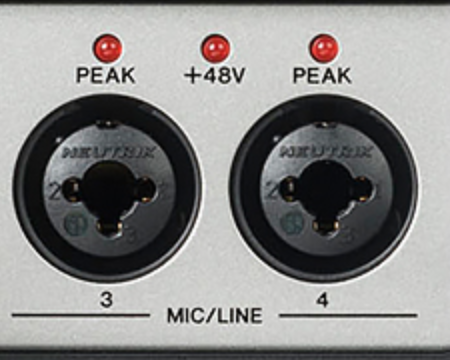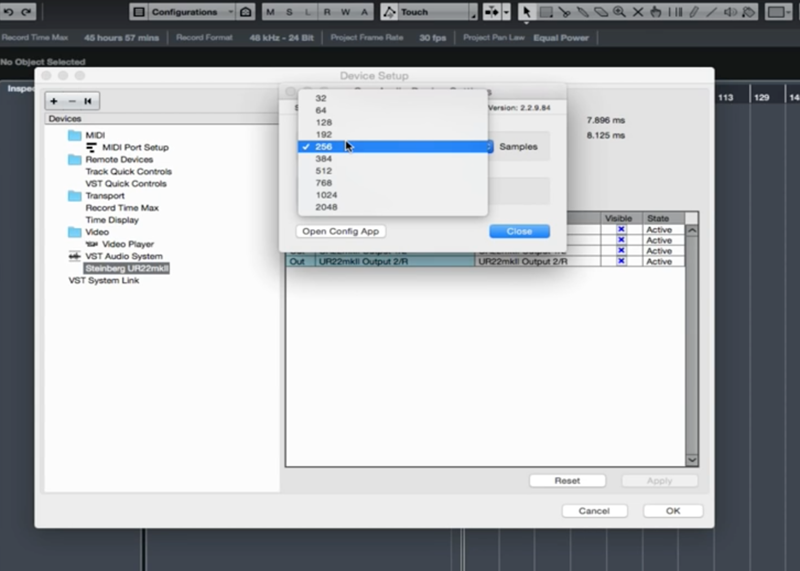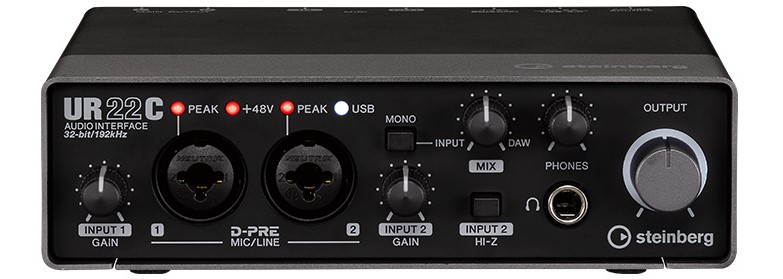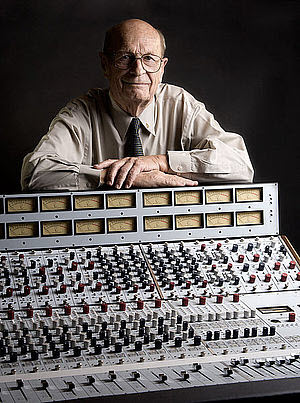How To Use An Audio Interface
Today's reckoner-based digital sound workstation (DAW) software gives you more recording and music production power than a studio full of hardware from the pre-digital days. But despite all the functionality that such software provides, its sound depends heavily on a piece of external hardware called an sound interface.
Such devices offer the connectors you demand to plug in microphones and instruments for recording as well as speakers and headphones for listening. They also typically provide metering and other important features. The more you understand about how interfaces piece of work, and the kinds of features they offer, the ameliorate positioned you'll exist to brand an informed ownership decision.
Connecting with Your Calculator
Modern audio interfaces connect to your desktop or laptop computer via a USB or Thunderbolt port (some older ones use different ports, such equally PCI, PCIe or Ethernet). Most interfaces work with both Mac® and Windows systems; many are as well compatible with Apple® iOS devices, although that usually requires an additional adapter.
Steinberg sound interfaces use the USB two.0 connectivity format, which is supported past virtually all computers. Note that y'all tin can utilize a USB two.0 interface on computers equipped with the newer USB three.0 format because USB is astern compatible.
Connecting and Converting Audio
An audio interface acts every bit the forepart finish of your estimator recording system. For example, let'due south say you connect a microphone and record yourself singing. The mic converts the concrete vibration of air into an equivalent (i.e., "analog") electrical signal, which travels down the connecting cable into the interface's mic input. From at that place, it goes into the interface'south congenital-in mic preamplifier, which boosts the depression-level mic signal up to a hotter line level — something that'southward necessary for recording. (The quality of both the microphone and preamp have a significant affect on how adept a recording sounds.)
Next, the signal gets sent to the interface's analog-to-digital ("A/D") converter, which changes it into equivalent digital audio data — a stream of ones and zeroes that travel through the USB or Thunderbolt cable into your computer. This data is then sent to your DAW or other recording software, where information technology gets recorded and/or candy with furnishings.
Almost simultaneously, the now-digitized audio that originated at your microphone — along with any other tracks you've already recorded for the song — become sent back from the computer to the audio interface over the USB cablevision, where it goes through an opposite quick alter, carried out by a digital-to-analog ("D/A") converter, which turns it back to an equivalent analog electrical signal. That point is now available at the interface'southward line outputs to feed your studio speakers, headphone output(s), or other line-level devices.
Nosotros're proverb almost simultaneously considering it actually takes a few milliseconds (thousandths of a second) for the audio to go through all these changes, from the time you showtime singing to the time you lot hear information technology back. That slight delay is called latency — something nosotros'll look at more closely shortly.
MIDI Too
Most audio interfaces too offer MIDI (Musical Instrument Digital Interface) inputs and outputs, which let you to connect a MIDI keyboard or other MIDI controller to your computer. The input(s) allow you to play software-based instruments ("virtual instruments") that open every bit plug-ins (software add-ons) within your DAW or as standalone applications. An interface'south MIDI output(s) makes information technology possible to connect an external MIDI audio source like a synthesizer or drum auto and have it "played" by MIDI data that you recorded in your DAW.

Sampling Rate and Bit Depth
If you're shopping for an sound interface, you've probably come beyond the terms sampling charge per unit and bit depth. Sampling rate refers to how often the A/D converter "looks" at the audio when converting information technology into digital data, unremarkably described in terms of kiloHertz (kHz for short), where one kHz equals a k samples per second. Flake depth describes how long the digital "words" are that describe each of these samples. It may seem a little techie, but all yous really need to know nigh these terms is this: The higher the number, the meliorate the audio … but also the larger the file size.
Some interfaces back up up to 24-bit 192 kHz audio, but that's overkill in many cases. The vast majority of people recording today use settings of 24-flake 96 kHz, which provides plenty of quality with reasonable file sizes. By comparison, the audio standard for a CD is a lot lower: 16-flake 44.ane kHz.
Ins and Outs
The number of inputs and outputs varies significantly between dissimilar audio interfaces. Steinberg interfaces, for example, run the gamut from the UR22C , which offers two inputs and two outputs (and is therefore referred to as a "two ten 2" interface) to the 28 10 24 AXR4 , which has 12 analog inputs and viii analog outputs, besides as an boosted 16 digital inputs and outputs in the ADAT Optical format then that y'all can gang other ADAT-equipped interfaces or mic preamp units to record more channels simultaneously. When recording large ensembles or bands with drums, even eight inputs may not be enough. Ever try to envision the maximum number of inputs yous'll need for the recording y'all plan on doing. If you can, effort to go out yourself a little room to grow, rather than merely opting for the minimum sized unit that will work.

About interfaces provide "combo connectors" for their mic input channels. These accept either XLR mic cables or one/4″ line and/or instrument inputs, giving you added flexibility.

Audio interfaces also usually provide something chosen phantom ability for the microphone inputs. This is a 48V electrical point that is required past condenser microphones — a type of mic that'south very popular for recording. On some interfaces, phantom power tin be turned on and off for individual channels, while on others it is switched for groups of channels at a time. (Click here to read our web log commodity explaining phantom power.)
In terms of outputs, almost all audio interfaces provide you lot with a stereo pair of ane/iv″ line outputs, which can be used to feed your monitor speakers. Others give you additional analog outputs, which you can use for connecting to other hardware in more sophisticated setups.
There will too be at to the lowest degree one headphone port, which is typically 1/four″ stereo. Some interfaces, such every bit the Steinberg UR44C and AXR4 , provide dual headphone outputs and allow you to send a dissever mix to each. This is benign when recording multiple musicians because inevitably, the various players or singers will non all agree on the balance they want to hear in their headphones.
Latency
As discussed earlier, in that location'due south a slight filibuster called latency that occurs because it takes the sound a number of milliseconds to travel through the interface input, into the estimator, back out of the computer and appear at the interface output. During recording, that can be distracting, because y'all'll hear your vox or your musical instrument coming back a little late, which can totally throw your timing off.
One way to deal with latency is to adjust the audio buffer (also known equally "buffer size") in your DAW to its lowest value. The buffer controls the corporeality of fourth dimension the computer allows for processing and is measured in samples (64, 128, 256, etc.). The lower the buffer, the less latency. The tradeoff is that lower buffer settings put more than strain on your reckoner, and that tin outcome in clicks, pops and diminished audio quality.

A better way to circumvent latency — and without impacting computer performance — is called "direct monitoring" (sometimes called "zippo-latency monitoring"), which is implemented on many sound interfaces, including all Steinberg models. It works like this: your interface sends a copy of your input signal (pre-computer) directly into the headphone output then that you lot can hear it in real time (with no latency) mixed with the tracks coming back from your reckoner.

Some basic interfaces provide this feature via a uncomplicated switch that allows y'all to choose between the direct point and the output of your host application, simply in more than sophisticated interfaces, such as the Steinberg UR22C , direct monitoring is implemented with a mix control knob that lets you adapt the ratio of the directly sound to the sound returning from the computer. Advanced models like the Steinberg UR-RT series even have digital processing (DSP) built in; all Steinberg interfaces offering this feature come with an app called DSPMixFx for controlling monitoring and adding effects from your computer, iPhone® or iPad®.

Audio Quality
Remember, we're talking audio interface, so audio quality is central. That'due south why the virtually critical components in any interface are its converters and mic preamps. Steinberg interfaces all come equipped with tiptop-of-range converters and Yamaha D-PRE mic preamps for consistently excellent sonics.

The Steinberg UR-RT2 and UR-RT4 interfaces take things upward a notch thanks to the addition of Rupert Neve Designs transformers that tin be switched into the point path on every mic aqueduct. A major designer of mixing consoles for more half a century, Rupert Neve products are renowned throughout the recording industry. With these interfaces, yous tin add together the legendary Neve sound to your home recordings.
An audio interface is more than than only a necessary peripheral device. It'due south the center of your studio. Whether you're buying your showtime i or replacing your current interface, exist sure to do all the necessary inquiry … and always get the all-time model your budget volition allow.
Click here for more data well-nigh Steinberg audio interfaces.
How To Use An Audio Interface,
Source: https://hub.yamaha.com/proaudio/recording/what-is-an-audio-interface/
Posted by: nicholstheacce.blogspot.com


0 Response to "How To Use An Audio Interface"
Post a Comment